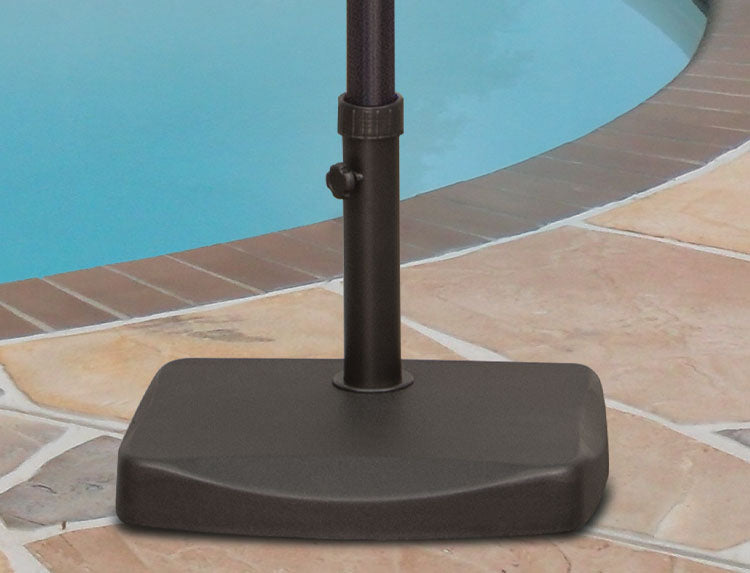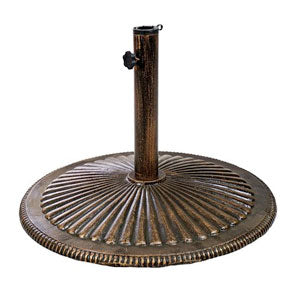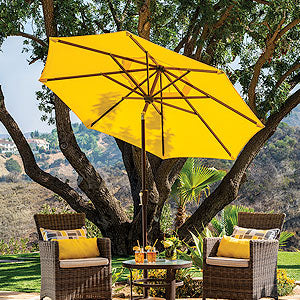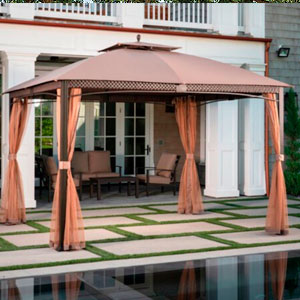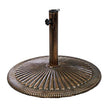Buying Guide
How To Choose a Patio Umbrella Base
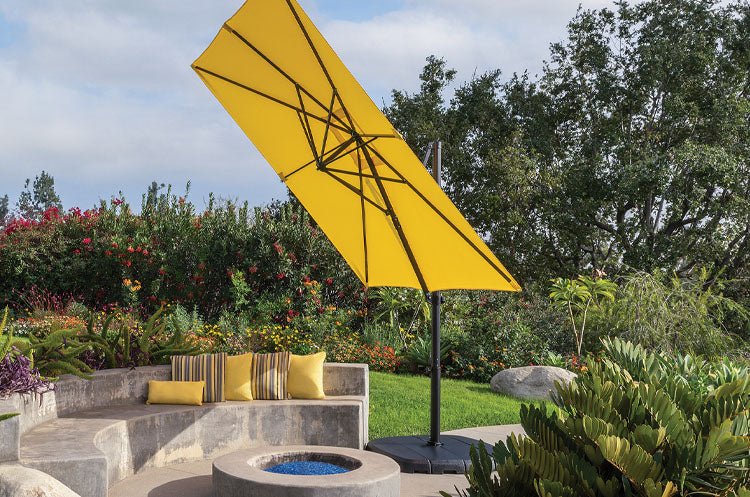
A patio umbrella is an essential accessory that keeps the sun out of your eyes or a light drizzle of rain out of your hair so you can fully enjoy the outdoors. But to keep it from taking flight when the wind kicks up, you’ll need a sturdy umbrella base or stand to hold it in place. Follow our tips on how to choose the right patio umbrella base to secure a shady spot on a sunny day.
Choose the Right Base for Your Umbrella Style
Not all patio umbrellas are the same; choose a base that supports your umbrella’s particular type. A standard patio umbrella, also called a market umbrella, is supported from underneath by a centerset pole. It requires a base with a center sleeve that holds the pole vertically. A cantilever or offset umbrella is suspended in the air and supported by a pole mounted at the side. Most cantilever umbrellas come with a crossbar-style base that provides balance but requires additional weight for stability; select a solid cantilever base, or use sandbags or weighted plates that fit around the bars. Once you learn which style of umbrella base you need, consider the following tips on how to choose the right one.
Select a Sturdy Base Material
A patio umbrella base must be constructed in a durable material that can stand up to different weather conditions. This item will stay outdoors for long periods of time, so plan on plenty of sun exposure, driving rain, wind, and humidity.
- Cast iron bases are heavy and strong. Look for a base with an enameled finish that won’t rust in a high-humidity area. Cast iron is the most typical material for a market patio umbrella base, and comes in designs from basic to elaborate.
- Heavy-duty concrete bases are often covered in aesthetically pleasing powder-coated steel. A steel-covered concrete base is sturdy, durable, and rust-resistant.
- A molded resin base or plate is weather resistant but requires a fill such as water or sand for weight. Water is lighter, making the base easier to move, and drains faster when it’s time to store. Sand is heavy and dense, making it a sturdier option in an area prone to windy weather.

Measure the Umbrella Base and Pole Diameters
Patio umbrella bases run the gamut in size, but the most typical measurement for a market-style umbrella base is 20 inches in diameter. This size takes up a smaller footprint and fits neatly around patio chairs and furniture. Cantilever bases and plates are usually bigger to help balance out the large canopy and the offset placement. These bases come as solid units or with separate plates, in sizes and shapes to fit the space.
Check the pole diameter of the patio umbrella to ensure a good fit. The most standard umbrella pole diameter is 1.5 inches, but some are as wide as 3 inches. Many umbrella bases adjust to accommodate a smaller size, but do not expand for a wider pole.
Pro tip: If you plan to mount the umbrella through the hole in a patio dining table, measure the height of the table to ensure the base will fit properly underneath it.

Find the Right Umbrella Base Weight
Patio umbrella bases come in a range of weights. A general rule of thumb to calculate the base weight for a patio umbrella is to simply multiply the width of the canopy by 10. For example, if the umbrella measures 7.5 feet wide, select a 75-pound base. A 9-foot wide umbrella needs a 90-pound base. In an area that experiences frequent high winds, opt for a heavier base regardless of the canopy diameter.
Pro tip: Solid bases are listed by weight, but fillable bases are typically listed by the weight of the unit once water or sand is added.
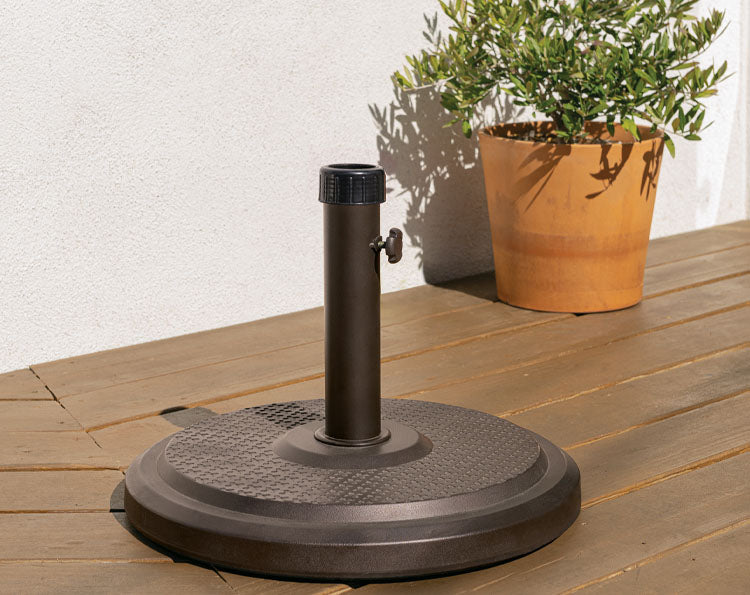
Additional Base Features To Consider
As long as it’s weighted correctly, and fits the décor and space, a basic base is sufficient to secure a patio umbrella. But some bases come with extra features for added convenience:
- Locking pole sleeve. A locking sleeve inside the pole holder provides extra support to hold the umbrella firm.
- Wheels. A base with wheels allows you to move the umbrella around the patio when the sun changes position.
- Rubber feet. An umbrella base with rubber pads or feet on the bottom reduces scratching and scraping a patio or deck.
- Hidden water plug. A fillable base with a plug placed discreetly in the rear or side of the base blends in seamlessly for a streamlined look.
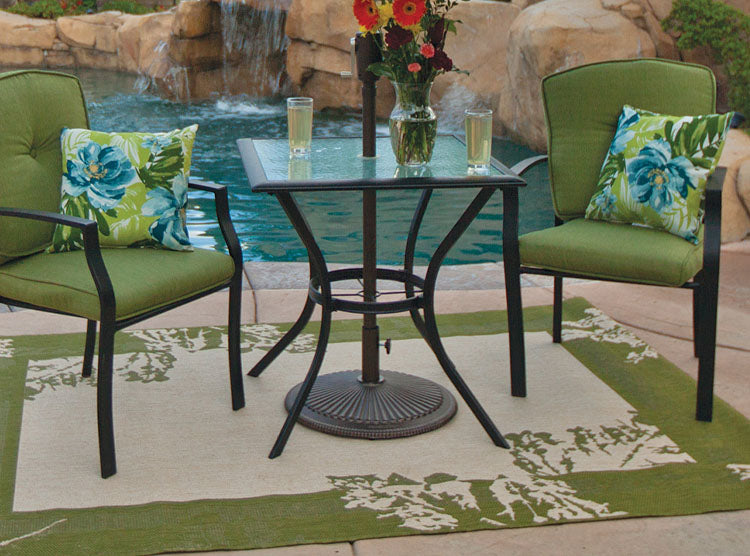
Finding the right base for a patio umbrella is easy once you know what to look for. For other helpful advice on outdoor décor, explore our tips on how to mix and match materials and outdoor accents on your patio or in the backyard.
Check out the selection of umbrellas, gazebos, and umbrella bases at Riverbend Home along with a wide selection of patio furniture and other outdoor products
